
The House of Hohenzollern is a formerly royal German dynasty whose members were variously princes, electors, kings and emperors of Hohenzollern, Brandenburg, Prussia, the German Empire, and Romania. The family came from the area around the town of Hechingen in Swabia during the late 11th century and took their name from Hohenzollern Castle. The first ancestors of the Hohenzollerns were mentioned in 1061.

A castle is a type of fortified structure built during the Middle Ages predominantly by the nobility or royalty and by military orders. Scholars usually consider a castle to be the private fortified residence of a lord or noble. This is distinct from a mansion, palace, and villa, whose main purpose was exclusively for pleasance and are not primarily fortresses but may be fortified. Use of the term has varied over time and, sometimes, has also been applied to structures such as hill forts and 19th- and 20th-century homes built to resemble castles. Over the Middle Ages, when genuine castles were built, they took on a great many forms with many different features, although some, such as curtain walls, arrowslits, and portcullises, were commonplace.

The Moselle is a river that rises in the Vosges mountains and flows through north-eastern France and Luxembourg to western Germany. It is a left bank tributary of the Rhine, which it joins at Koblenz. A small part of Belgium is in its basin as it includes the Sauer and the Our.

The Wartburg is a castle originally built in the Middle Ages. It is situated on a precipice of 410 metres (1,350 ft) to the southwest of and overlooking the town of Eisenach, in the state of Thuringia, Germany. It was the home of St. Elisabeth of Hungary, the place where Martin Luther translated the New Testament of the Bible into German, the site of the Wartburg festival of 1817 and the supposed setting for the possibly legendary Sängerkrieg. It was an important inspiration for Ludwig II when he decided to build Neuschwanstein Castle.
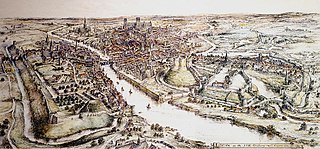
A motte-and-bailey castle is a European fortification with a wooden or stone keep situated on a raised area of ground called a motte, accompanied by a walled courtyard, or bailey, surrounded by a protective ditch and palisade. Relatively easy to build with unskilled labour, but still militarily formidable, these castles were built across northern Europe from the 10th century onwards, spreading from Normandy and Anjou in France, into the Holy Roman Empire, as well as the Low Countries it controlled, in the 11th century, when these castles were popularized in the area that became the Netherlands. The Normans introduced the design into England and Wales. Motte-and-bailey castles were adopted in Scotland, Ireland, and Denmark in the 12th and 13th centuries. By the end of the 13th century, the design was largely superseded by alternative forms of fortification, but the earthworks remain a prominent feature in many countries.
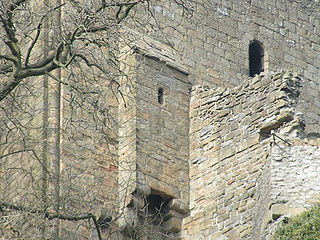
Garderobe is a historic term for a room in a medieval castle. The Oxford English Dictionary gives as its first meaning a store-room for valuables, but also acknowledges "by extension, a private room, a bed-chamber; also a privy".
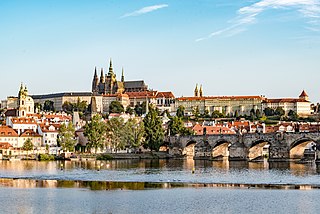
Prague Castle is a castle complex in Prague, Czech Republic serving as the official residence and workplace of the president of the Czech Republic. Built in the 9th century, the castle has long served as the seat of power for kings of Bohemia, Holy Roman emperors, and presidents of Czechoslovakia. As such, the term "Prague Castle" or simply the "Castle" or "the Hrad" are often used as metonymy for the president and his staff and advisors. The Bohemian Crown Jewels are kept within a hidden room inside it.
A castellan, or constable, was the governor of a castle in medieval Europe. Its surrounding territory was referred to as the castellany. The word stems from castellanus. A castellan was almost always male, but could occasionally be female, as when, in 1194, Beatrice of Bourbourg inherited her father's castellany of Bourbourg upon the death of her brother, Roger. Similarly, Agnes became the castellan of Harlech Castle upon the death of her husband John de Bonvillars in 1287. The title of "governor" is retained in the English prison system, as a remnant of the medieval idea of the castellan as head of the local prison.

Visegrád is a castle town in Pest County, Hungary. It is north of Budapest on the right bank of the Danube in the Danube Bend. It had a population of 1,864 in 2010. The town is the site of the remains of the Early Renaissance summer palace of King Matthias Corvinus of Hungary and a medieval citadel.

A keep is a type of fortified tower built within castles during the Middle Ages by European nobility. Scholars have debated the scope of the word keep, but usually consider it to refer to large towers in castles that were fortified residences, used as a refuge of last resort should the rest of the castle fall to an adversary. The first keeps were made of timber and formed a key part of the motte-and-bailey castles that emerged in Normandy and Anjou during the 10th century; the design spread to England, Portugal, south Italy and Sicily. As a result of the Norman Conquest of England in 1066, use spread into Wales during the second half of the 11th century and into Ireland in the 1170s. The Anglo-Normans and French rulers began to build stone keeps during the 10th and 11th centuries, including Norman keeps, with a square or rectangular design, and circular shell keeps. Stone keeps carried considerable political as well as military importance and could take a decade or more to build.
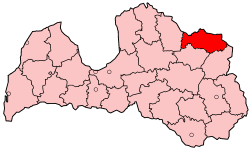
Alūksne district was an administrative division of Latvia, located in Vidzeme region, in the country's north-east, 202 km (126 mi) from the capital city Riga. The district had international borders with Estonia and Russia, and internal borders with the districts of Valka, Gulbene and Balvi. The main city in the district was Alūksne.

Ordensburg is a German term meaning a "castle of a (military) order". It is used specifically for the fortified structures built by crusading German military orders during the Middle Ages.
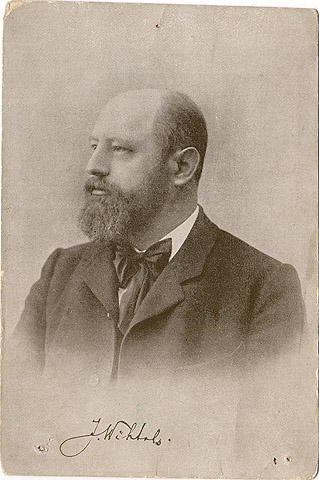
Jāzeps Vītols was a Latvian composer, pedagogue and music critic. He is considered one of the fathers of Latvian classical music.

Predjama Castle is a Renaissance castle built within a cave mouth in south-central Slovenia, in the historical region of Inner Carniola. It is located in the village of Predjama, approximately 11 kilometres from the town of Postojna and 9 kilometres from Postojna Cave.

Gaujiena Parish is an administrative unit of Smiltene Municipality, Latvia. The administrative center is the village of Gaujiena.

Zvārtava Manor is a manor house in Gaujiena Parish, Smiltene Municipality in the historical region of Vidzeme, northern Latvia. It was built in 1881 in Tudor Neo-Gothic style.

Alūksne Castle is a castle of Teutonic Knights in current Alūksne, North-Eastern Latvia.
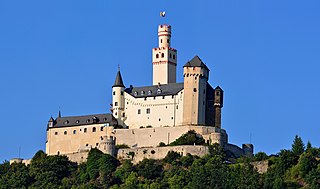
A hill castle or mountain castle is a castle built on a natural feature that stands above the surrounding terrain. It is a term derived from the German Höhenburg used in categorising castle sites by their topographical location. Hill castles are thus distinguished from lowland castles (Niederungsburgen).

Gaujiena Palace is a palace in the historical region of Vidzeme, in northern Latvia.

Cēsis county was a historic county in the Swedish Livonia, in the Governorate of Livonia, and in the Republic of Latvia dissolved during the administrative territorial reform of the Latvian SSR in 1949. Its capital was Cēsis (Wenden).

























